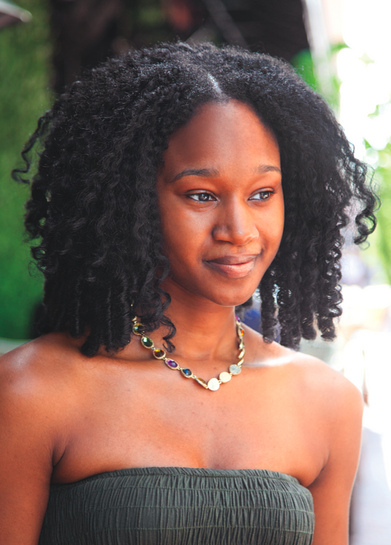
Moisture retention is one of the biggest healthy hair concerns for many naturals. Thanks to science, the quest for the perfect thirst-quenching product is a bit easier now than it was before. Turns out, for most of us, there is no one-item wonder. Sealing in moisture takes at least two steps, and in some cases, three. Wondering which routine will work best for you? Well, that involves knowing your hair porosity. From there, you can better determine whether the LCO or LOC method gives you lasting, layered moisture.
SEE MORE: 4 Ways to Treat Natural Hair with High Porosity
Hair Porosity: The Highs and Lows
There are a number of resources that can help you determine your hair porosity, or its ability to absorb moisture. Remember that porosity is a sliding scale that ranges from low to normal to high. For the purpose of reviewing each moisture method, we’ll stick with low and high porosity.
Low porosity hair has a tighter cuticle layer made of overlapping scales that are harder to penetrate. These strands appear smoother under microscope, and are usually very shiny to the human eye. Highly porous strands appear coarser with open or raised scales, which easily allow moisture in or out. This type of hair is prone to frizz and tangling, especially in humid weather.
Layered Moisture: Liquid, Cream, Oil (LCO) Method
Layering products on the hair allows us to control how much moisture is absorbed and how quickly it evaporates. Hair can be styled wet or damp, with heavy or light liquids, creams and oils.
Let’s examine how low porosity strands respond to the LOC method. When saturated with a liquid, low porosity hair will slowly absorb and retain just the moisture it needs. Once a cream is added, it will absorb the water content from the product, leaving the rest to coat and seal its strands. Then, when oil is applied, the two outermost layers will mix and form a thicker barrier to protect the strands. Depending on how low your hair’s porosity is, this cream and oil mix can leave your hair weighed down and greasy.
High porosity hair, however, often responds more favorably to layering creams and oils. When wet, it quickly takes in more liquid than it needs, which causes swelling and lifting of its scales. Once a cream is applied, it absorbs a lot of the product and leaves only a little to coat and relax/smooth the cuticles. The right oil will mix with the cream layer and create a lighter, more flexible coating.
If you have high porosity hair, here are 4 things you can do to improve your hair’s porosity.
3 Natural Hair Products That Decrease Hair’s Porosity
amzn_assoc_placement = “adunit0”;
amzn_assoc_search_bar = “true”;
amzn_assoc_tracking_id = “nathairul_recommandationads-20”;
amzn_assoc_ad_mode = “manual”;
amzn_assoc_ad_type = “smart”;
amzn_assoc_marketplace = “amazon”;
amzn_assoc_region = “US”;
amzn_assoc_title = “Products That Decrease Porosity”;
amzn_assoc_linkid = “1ef5ac832cc5145dea364673670e76ca”;
amzn_assoc_asins = “B00KH6RU2S,B002NVPXX8,B003YELGF2,B0072Z0YGG”;
//z-na.amazon-adsystem.com/widgets/onejs?MarketPlace=US
SEE MORE: Stylist’s Choice: Products for Your Hair’s Porosity
Liquid, Oil, Cream (LOC) Method
Similar to the above routine, the LOC method can leave low porosity hair weighed down with product buildup. To prevent this, consider using a lightweight oil opposed to thick, penetrating ones like coconut and olive oils. Jojoba, sweet almond and argan oils will coat the hair while still allowing strands to breathe. Then, when a cream is applied, hair will feel smooth and slick without the greasiness.
Adding oil after a liquid can protect high porosity hair by sealing its cuticles and preventing hygral fatigue. This is damage that occurs from repeated expansion and contracting of hair fibers. After penetration, a small amount of the oil is left to coat the hair. When a cream is applied, what’s needed is absorbed and what’s left acts as a protective coating against environmental elements (evaporation, damaging sun rays, etc.).
amzn_assoc_placement = “adunit0”;
amzn_assoc_search_bar = “true”;
amzn_assoc_tracking_id = “nathairul_recommandationads-20”;
amzn_assoc_ad_mode = “manual”;
amzn_assoc_ad_type = “smart”;
amzn_assoc_marketplace = “amazon”;
amzn_assoc_region = “US”;
amzn_assoc_title = “Oils for Low Porosity”;
amzn_assoc_linkid = “2493da50ecf07916479fff023468adbd”;
amzn_assoc_asins = “B0019LTGOU,B0019LVFSU,B004Z209HS,B00128WK4I”;
//z-na.amazon-adsystem.com/widgets/onejs?MarketPlace=US
Which is Best? Well…
That depends on your preference. For low porosity hair that’s also very thick, layering may not cause product buildup. If it does, try eliminating one layer at a time to see which provides maximum moisture (LC or LO). For hair that’s highly porous but not fatigued, then LCO is your way to go. And if not? Try LOCing in moisture with oil first to kiss dry, dull, lifeless hair goodbye.
What say you, trusted reader? Do you LCO or LOC for lasting, layered moisture?













